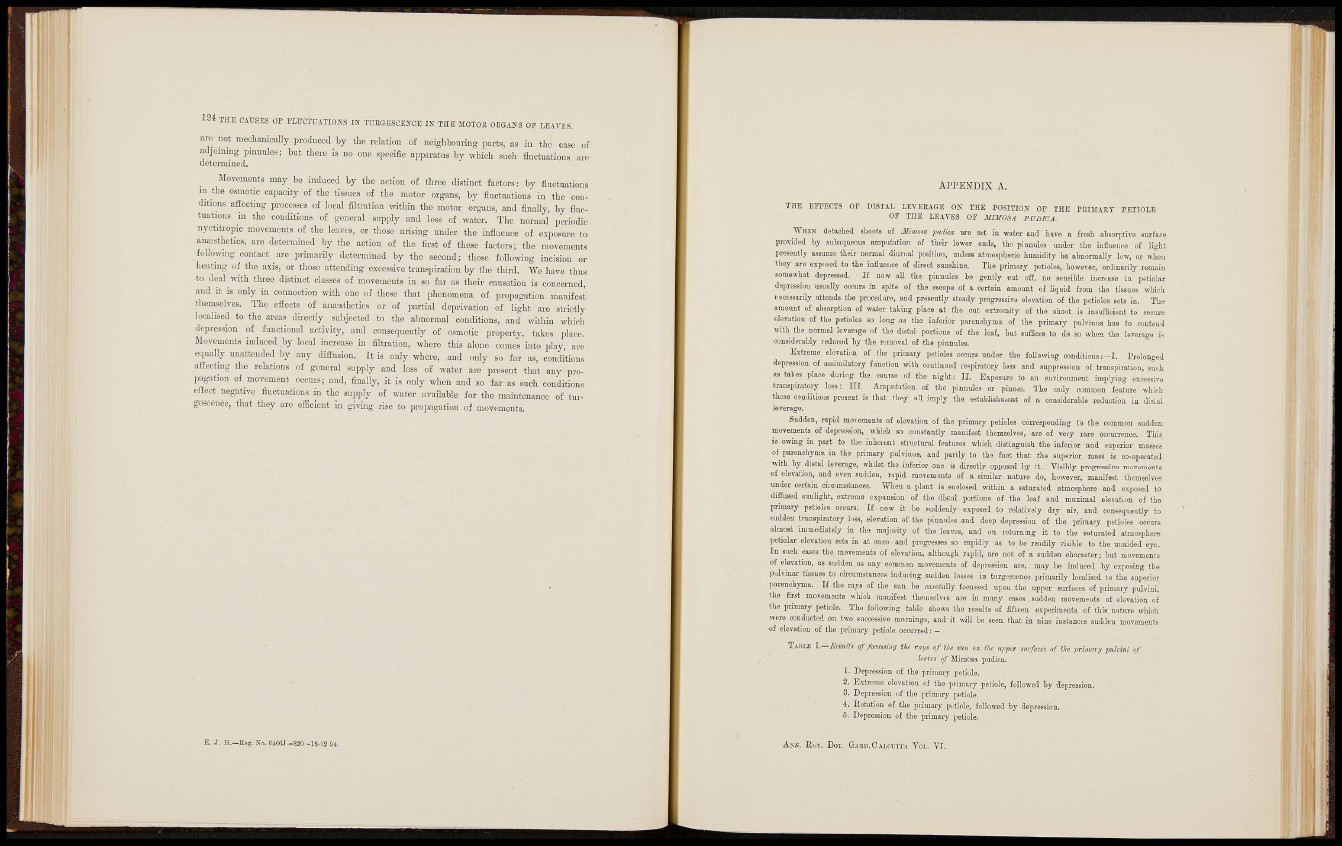
134 THE CAUSES OP FLUCTUATIONS IN TUEGESCEXCE IN THE MOTOK OEGANS OF LEAVKS.
arc not n,ec!ianioa]]y produced Ly the relation of neighbounng parts, as in the case of
adjommg pmnules; but there is no one specific apparatus by which such fluctuatio.is ni'c
cietcmiued.
^ Morements may be induced l y the action of three distinct factor«: by fluctuations
lu the osmotic capacity of the tissues of the motor organs, by fluctuations in the conditions
affecting processes of local filtration witliin the motor organs, and finally by fluctuations
in the conditions of general supply and loss of water. Tlic normal periodic
nyctitropic movements of the leaves, or those arising under the influence of exposure to
an^sthotics, are deteraiiued by the action of the first of these factors; the movements
following contact are primarily determined by the second; those following incision or
heating of the axis, or those attending excessive ti-anspiration by the third. We have thus
to deal with tln-ee distinct classes of movements in so far as their causation is concerned,
and It IS only in connection with one of these that phenomena of propagation nmnifest
themselves. The effects of anjcsthetics or of partLal deprivation of light are strictly
localised to the areas dnectly subjected to the abnormal conditions, and within which
.lopression of functional activity, and consequently of osmolic property, takes place.
Movements induced by local increase in filtration, where this alone comes into play, are
equally unattended by any diffusion. It is only where, and only so far as, conditions
affecting the relations of general supply and loss of water ai« present tliat any propagation
of movement occurs; and, finally, it is only when and so far as such conditions
effect negative fluctuations in the supply of water avaHable for the maintenance of turgescence,
that they are efficient in giving rise to propagation of movements.
E. J . H.-Heg. So. 6406J-320-18.12 94.
A P P E N D I X A.
THE EFFECTS OF DISTAL LEVEE.iGE ON THE POSITION OF THE PRTMAET PETIOLE
OP THE LEAVES OP ^fmOSA PUDICA.
WHEN detached slioots ot Mimosa pudloa ure set in water and Lave a ftesli absorptive surface
provided by subaqueous (imputation of their lower ends, tka pinnules under the influence of light
presently assume their normal diurnal positioci, uuless atmospheric humidity be abnormally low, or when
they are exposed to the infiuence of direct sunshine. The primary petioles, however, ordinarily remain
somewhat depressed. If now nil the pinnules bo gently «ut off, no sensible increase in petiolar
dopressiou usuuUy occurs in spita of the escape of a certain amount of liquid from the tissues which
i:eeessarily attends th« procedure, aud presently steady progressive elevation of the petioles sets in. The
amount of absorption of water taliing place at the cut extremity of tho shoot is insuffioient to secure
elevation of the petioles so long as the inferior parenchyma of the primary pulvinus has to contend
with the nonaol levernge of the distal portions of the leaf, but suffices to do BO when the leverage is
ooasiderably reduced by the removal of the pinnules.
Extreme elevatiun of the primary petioles occurs under the following conditions:-!. Prolonged
depression of as.imilatory function with continued respiratory loss and suppression of transpiration, such
as takes place duri„g the course of the night: II. Exposure to an euvironme.nt implying escessive
transpiratory loss: III. Arapntntion of the pinnules or pinn®. The only comraon feature which
these conditions present is that they all imply the establishn.ent of a considerable reduction in distal
teverage.
Sudden, rapid movement-s of elevation of the primary petioles corresponding to the common sudden
movements of depression, which so constantly manifest themselves, are of very rare occurrence. This
is owing in part to the inhereat structural features which distinguish the inferior and superior masses
of parenchyma in the primary pulviuus, and partly to the fact that the superior mass is co-operated
with by distal leverage, whilst, the inferior one is directly opposed by it. Visibly progressive movements
of elevation, and even sudden, r;ipid niovemonts of a similar nature do, however, manifest themselves
under certain ciroumstanoea. When a plant is enclosed witliin a saturated atmosphere aud exposed to
diffused sunlight, extreme expansion of the distal portions of the leaf and maximal elevation of the
primary petioles occurs. If now it be suddenly exposed to relatively dry ah, and conseqnentlv to
.sudden transpiratory less, elevation of the pinn.des aud deep depression of tlie primary petioles occurs
almost immediately in the majority of the leaves, and on returning it to the saturated atmosphere
petiolar elevation sets ii» at cnee and progresses so rapidly as to be readily visible to the unaided eye.
In such cases the movements of elevation, although rapid, are not of a sudden character; but movements
of elevation, as sudden as any common movements of depression are, may be induced by exposing the
pulvinar tissues to circumstances inducing sudden losses in turgescence primarily localised to the superior
parenchyma. If the rays of the sun be carelully foeussed upon the upper surfaces of primary pulvini,
the first movements which manifest themselves are in many eases sudden movements of elevation of
the pumary petiole. The following table shows the results of fifteen experiments of this nature which
^vere conducted on two successive mornings, and it will be seen that in nine instances sudden movements
«f elevation of tho primary petiole occurred: -
TAHLE l.~Iiesu/U of.foou^n'<g tko rays of the snn on ihc nppcT mrfaees of VK primary pulvini of
koMs of Mimosa pudica.
1. Depi-ossion of the primary petiole.
2. Extreme elevation of the primary petiole, followed by depression.
3. Depression of the primary petiole.
4. Eolation of the primary pL-tiole, followed by depression.
5. Depression of the primary petiole.
A s s . ROV. BOT. GAUD. C ALCUTTA TOL. V I.